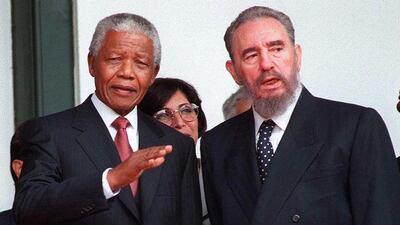The only time I saw Fidel Castro in the flesh was when he came to Cape Town at the invitation of Nelson Mandela, the newly elected president, to address the South African parliament in 1995. Castro was a huge hero to the ANC, exceeded only by Che Guevara whose poster was on every old warrior’s bedroom wall. His Russian-backed troops had fought white South African forces to a standstill in the jungles of Angola in the 1970s, and many of the old ANC guard had been trained by them and even been to Cuba.
I was in the gallery, gawping along with everyone else, as two of the best-known old men in the world took their places beside the speaker’s chair. Castro proved a disappointing figure: shrunken, his beard now grey, and much smaller than Mandela who stood well above 6 feet.
The Cuban president’s address was even more uninspiring than his appearance. He spoke in a surprisingly reedy voice, congratulating his old ANC friends on their victory over the dark forces of apartheid, attacking the Americans for propping up the old “colonial” regime and only getting into his stride as he proclaimed a great global financial crash and the collapse of capitalism. There had been a recent setback on the New York stock market, which had fallen a couple of per cent in a week – I can’t now even remember why – and he used this as clear proof that the end was nigh. Within a week the “crash” – more a market correction – was over and world capitalism resumed.
A few years ago I went to Cuba with some American friends and, like everybody else, was enchanted by the place. Americans were not allowed in as normal tourists, so we travelled as a cultural group under the aegis of the Washington Ballet Company whose director was a Cuban. I tagged along as we were shown the economic miracle 60 years of communism had created.
It was not impressive. The economy, according to the Harvard Business Review, suffered a catastrophe after the Russians pulled out and in the first four years of the 1990s an estimated one-third of the economy disappeared. The recovery since has been painfully slow, aided briefly in the 2000s when Venezuela, in return for providing doctors and medical aid (one of Cuba's biggest exports), supplied oil at deeply discounted market prices. But that ended just before the 2008-09 financial crisis and since then, there has been no recovery at all. Cuban officials claim a 2 per cent growth rate, but a helpful economic adviser in the US embassy, which had just reopened for business, reckoned that, given the unreliability of Cuban figures, it was actually a lot closer to zero. That's grim.
There are some even grimmer statistics. The population of 11.2 million people is shrinking and rapidly ageing and primary schools are closing to be replaced by old-age homes. Infrastructure is almost non-existent and the modern technological age has yet to arrive – there are seven computers per 100 people, one of the lowest ratios in the Americas. Internet access, such as it is, is very expensive, well beyond the reach of the average salary, which is US$20 a month.
Most surprising of all is the fact that Cuba imports over 70 per cent of its food, and most of that is rationed to the public. Before the revolution in 1959, Cuba had as many cattle as people. Today meat is so scarce that it is a crime to kill a cow without government permission. Before we arrived friends warned us to brace ourselves for some of the worst food in the world – and expect to be disappointed. That could not have been more right.
And yet there are flickers of hope. In his final years, Fidel allowed his brother Raúl to move away from the old Soviet model of centralised planning and permit a few self-employment enterprises.
One example: visitors used to find that, although there were plenty of 1950s vintage cars available as taxis, drivers did not want the work because they could not keep the proceeds. Result: no taxis available. Then the government allowed owner-drivers, and today taxis follow you down the pavement competing for hire.
Similarly, a few years ago the country ran out of bananas and incentivised farmers to produce them. The result: you’ve guessed it – a glut of bananas. Given the slightest encouragement, and an end to the American embargo, the place could boom. Tourism alone could revive the whole economy. And cigar aficionados around the world still smoke only hand-rolled Havanas.
So what happens now? US president-elect Donald Trump has blown hot and cold on Barack Obama’s policy of detente, at first saying he supported it but would seek “a better deal”, then pledging to “reverse” Mr Obama’s approach.
A friend of mine has been buying pre-revolution Cuban bonds for the past 40 years, at prices of about 5 cents in the dollar, on the basis that before the country is allowed to re-enter the world’s capital markets it must settle its old debt. Maybe his day has come at last.
Ivan Fallon is a former business editor of The Sunday Times.
business@thenational.ae
Follow The National's Business section on Twitter

